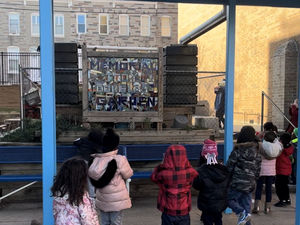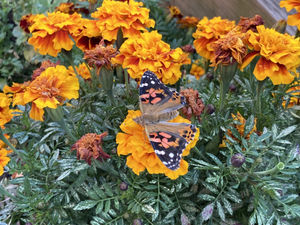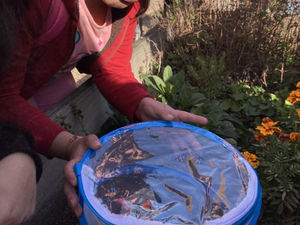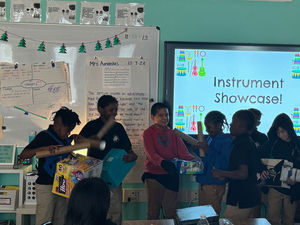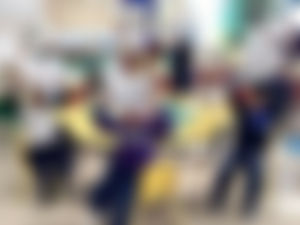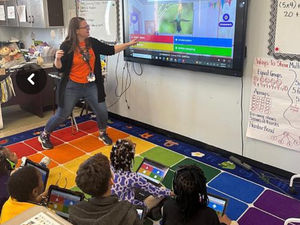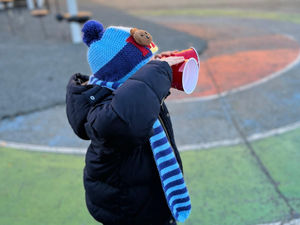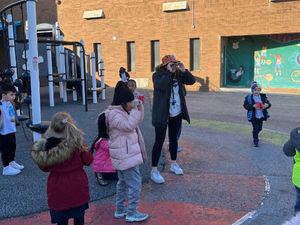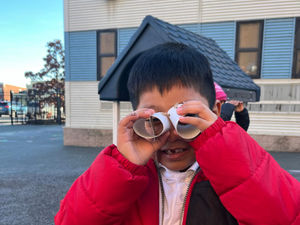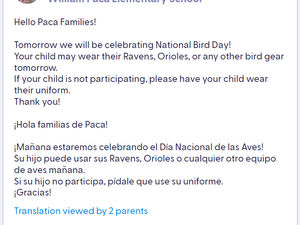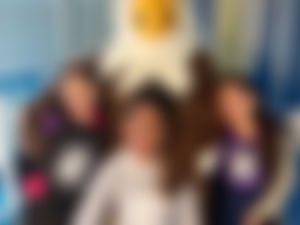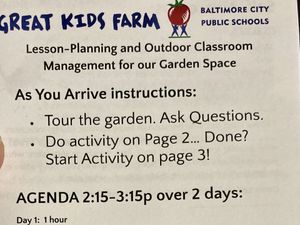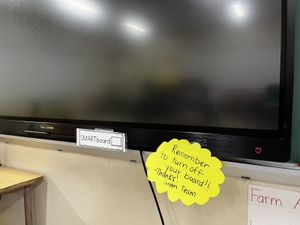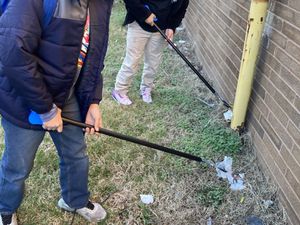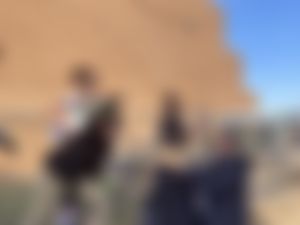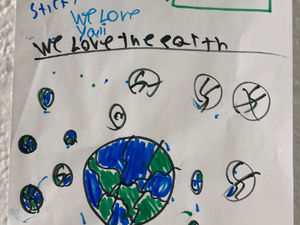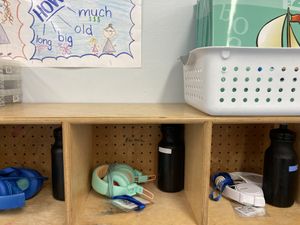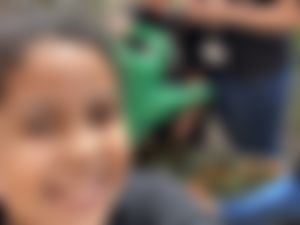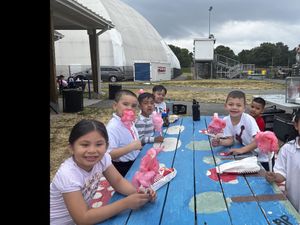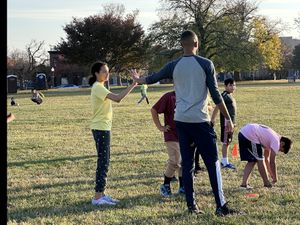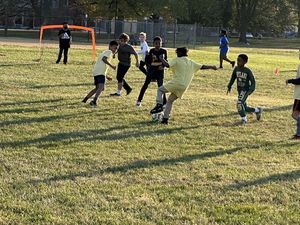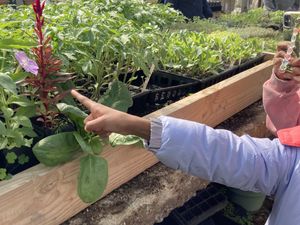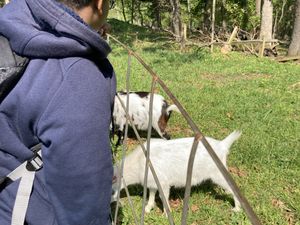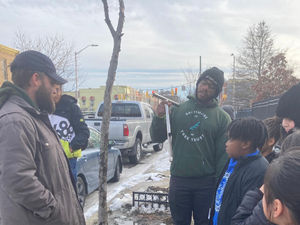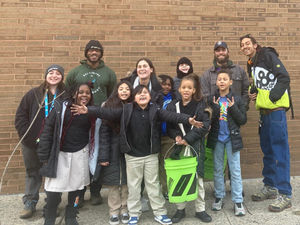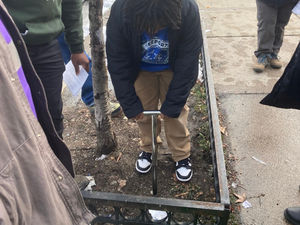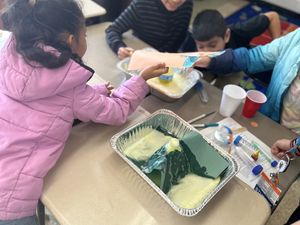Systemic Sustainability
Environmental Curriculum and Instruction
1.1 Curriculum and Instruction
Elementary & middle schools must provide one example of outdoor/environmental instruction per grade level.
High schools must provide one example of outdoor/environmental instruction in four subjects (which may include multiple different differents sciences).
The students learned about the season of spring and the seasonal changes that take place (e.g., flowers growing, leaves returning, weather gets warmer etc.). In addition to exposure to theme-related text, students had the opportunity to observe, explore, and investigate weather changes, and changes related to spring plants and animals as they occur in nature. They used their senses to experience the different smells, tastes, sounds, and textures of spring. Students explored the campus grounds to find evidence of spring, including small flowers starting to bloom in the grass!
To introduce the plants and animals science unit, students explored what is living and nonliving by going on a nature walk outside. Students had to identify one living and one nonliving object, where they compiled a class list of living and nonliving things.
As part of the “What Do Plants Need” science unit, second graders learned about the needs and purposes of plants, with a focus on pollinators. Students created a “bug hotel” with recycled materials to attract pollinators. Students left the hotels outside to see what bugs came!
Students learned about the insect life cycle and compared the life cycles of various species. Students observed the life cycles of caterpillars’ transformation into monarch butterflies. The unit culminated with setting the butterflies free in the William Paca garden and wishing them well on their journeys!
As part of the Music to My Ears unit, in which students learn about the science of sound, 4th graders were challenged to use recycled materials to create new instruments. Students learned about the concept of upcycling in creating new items through the story Ada’s Violin. Students then got hands-on experience in reusing old materials to make their instruments!
Students began their study of the Chesapeake Bay watershed by learning about various bays around the world. 5th grade students drew pictures of the various bays studied and wrote descriptions. Helping students to understand the watershed we live in is a foundation in learning about problems affecting the watershed and steps students can take to protect it.
5th grade.1 (584.44 KB)
5th grade students describe what they have learned about bays in pictures and words
5th grade.2 (471.77 KB)
5th grade students describe what they have learned about bays in pictures and words
5th grade.3 (525.87 KB)
5th grade students describe what they have learned about bays in pictures and words
As the introduction to the “Calls of the Wild” science unit, students were introduced to the five senses. They used their imagination to take a “trip” to the park, and imagined what they would see, hear, smell, touch, and taste there. Students drew on their imagination and past experiences to describe the living and nonliving things they might encounter there.
1st grade 1 (113.84 KB)
1st grade students drew pictures to show what they have experienced seeing, hearing, touching, tasting, and smelling in the park
1st grade 2 (105.08 KB)
1st grade students drew pictures to show what they have experienced seeing, hearing, touching, tasting, and smelling in the park
1st grade 3 (125.16 KB)
1st grade students drew pictures to show what they have experienced seeing, hearing, touching, tasting, and smelling in the park
1.2 Green School Awareness
1.2.1 School Wide Awareness - Staff
Demonstrate that all school personnel are aware of your school's Green School status and application process.
Staff were informed of the Green School application process through a whole-school email sent on January 24, 2024. More information about the process was also shared at the faculty meeting on February 15, 2024. The email, agenda, and sign-in sheets are shared. A photo of Sarah Moenter, one of our Green Leaders, presenting at the staff meeting is also included
Sarah Moenter presented on the purpose of the Green School certification and the steps in our application at our faculty meeting.
This email went out to the whole staff sharing efforts for the Green School application
Green School Cert Announcement (362.56 KB)
This shows an email that went out to all William Paca staff sharing about our Green School application process
1.2.2 School-Wide Celebration
Demonstrate how your school celebrates beig a Green School by hosting a school-wide environmentally-focused event open to all students.
The William Paca community celebrated its many connections to birds by hosting its annual celebration for National Bird Day! Our school's mascot is the Eagle, and also proudly supports the hometown bird-teams in Baltimore: the Orioles and Ravens. To celebrate, students schoolwide participated in making recycled art projects, dressed up for the spirit day, went birdwatching in our courtyard, celebrated with our eagle mascot, learned about bird conservation efforts, and played trivia games to showcase their knowledge. More than 400 students celebrated across the grade levels.
The William Paca community celebrated its many connections to birds by hosting its annual celebration for National Bird Day! Our school's mascot is the Eagle, and also proudly supports the hometown bird-teams in Baltimore: the Orioles and Ravens. To celebrate, students schoolwide participated in making recycled art projects, dressed up for the spirit day, went birdwatching in our courtyard, celebrated with our eagle mascot, learned about bird conservation efforts, and played trivia games to showcase their knowledge. More than 400 students celebrated across the grade levels.
This photo shows students from Pre-K who celebrated National Bird Day by learning to draw our school mascot, the eagle
This photo shows students from 3rd grade who celebrated National Bird Day by learning about bird conservation and different types of birds, and then participated in a Kahoot trivia game to showcase their knowledge
This photo shows students from 3rd grade who celebrated National Bird Day by creating a poster out of reused art materials (leftover paper scraps and cardboard)
This photo shows students from 3rd grade who celebrated National Bird Day by wearing their favorite bird memorabilia (including the Ravens, Orioles, and our school mascot)
This photo shows a Kindergarten student who celebrated National Bird Day by creating his own "binoculars" from recycled materials to go birdwatching
This photo shows students in Kindergarten who celebrated National Bird Day by creating their own "binoculars" from recycled materials to go birdwatching
This photo shows a 1st grade student who celebrated National Bird Day by creating his own "binoculars" from recycled materials to go birdwatching
This ClassDojo post shows an announcement to the parents/school community informing them about the celebration and opportunity to dress up
This photo shows the finished product of our National Bird Day poster made of recycled or leftover materials
This photo shows students in 2nd and 3rd grade celebrating National Bird Day with our eagle mascot!
Bird Day info (94.42 KB)
This email shows information to the teachers on possible Bird Day activities and ways to celebrate
Environmental Professional Development for Teachers
1.3.1 Environmental Professional Development for Teachers
Demonstrate that 10% of staff have completed an environmental PD. Instructional staff is defined as any staff that manages a gradebook.
- New Schools must have all PD completed within the past 2 academic years.
- Renewing schools must have all PD completed within the past 4 academic years.
A teacher who has participated in multiple workshops may only be counted once..
10 teachers attended and engaged in workshops developed and facilitated by Laura Menyuk from Great Kids Farm. Teachers discussed the impacts of outdoor learning on students' social, emotional, and academic development. Teachers also reviewed curriculum and discussed opportunities for providing their students with increased educational time spent outside. Teachers were able to complete a risk analysis to help problem-solve on ensuring safe procedures could be in place in using the outdoors for classes.
Eight of the teachers listed attended and engaged in two hour-long workshops developed and facilitated by Great Kids Farm. Two additional teachers attended the second session. Teachers discussed the benefits of outdoor learning for students' academic and social-emotional wellbeing. Teachers collaborated to plan for how to best use the outdoors to support and enrich our curriculum.
PD Sign in 2-8 (58.94 KB)
Sarah Moenter, a special educator, attended the outdoor learning training on 2/8 and 2/9
PD Sign In 2-9 (67.15 KB)
Sarah Moenter, a special educator, attended the outdoor learning training on 2/8 and 2/9
Eight of the teachers listed attended and engaged in two hour-long workshops developed and facilitated by Great Kids Farm. Two additional teachers attended the second session. Teachers discussed the benefits of outdoor learning for students' academic and social-emotional wellbeing. Teachers collaborated to plan for how to best use the outdoors to support and enrich our curriculum.
PD Sign in 2-8 (58.94 KB)
Nicole White, William Paca's library teacher, attended the outdoor learning training on 2/8 and 2/9
PD Sign In 2-9 (67.15 KB)
Nicole White, William Paca's library teacher, attended the outdoor learning training on 2/8 and 2/9
Eight of the teachers listed attended and engaged in two hour-long workshops developed and facilitated by Great Kids Farm. Two additional teachers attended the second session. Teachers discussed the benefits of outdoor learning for students' academic and social-emotional wellbeing. Teachers collaborated to plan for how to best use the outdoors to support and enrich our curriculum.
PD Sign in 2-8 (58.94 KB)
Matt Allen, physical education teacher, attended the outdoor learning training on 2/8 and 2/9
PD Sign In 2-9 (67.15 KB)
Matt Allen, physical education teacher, attended the outdoor learning training on 2/8 and 2/9
Eight of the teachers listed attended and engaged in two hour-long workshops developed and facilitated by Great Kids Farm. Two additional teachers attended the second session. Teachers discussed the benefits of outdoor learning for students' academic and social-emotional wellbeing. Teachers collaborated to plan for how to best use the outdoors to support and enrich our curriculum.
PD Sign in 2-8 (58.94 KB)
Akil Lewis, behavior specialist, attended the outdoor learning training on 2/8 and 2/9
PD Sign In 2-9 (67.15 KB)
Akil Lewis, behavior specialist, attended the outdoor learning training on 2/8 and 2/9
Eight of the teachers listed attended and engaged in two hour-long workshops developed and facilitated by Great Kids Farm. Two additional teachers attended the second session. Teachers discussed the benefits of outdoor learning for students' academic and social-emotional wellbeing. Teachers collaborated to plan for how to best use the outdoors to support and enrich our curriculum.
PD Sign in 2-8 (58.94 KB)
Taylor Riley, art teacher, attended the outdoor learning training on 2/8 and 2/9
PD Sign In 2-9 (67.15 KB)
Taylor Riley, art teacher, attended the outdoor learning training on 2/8 and 2/9
Eight of the teachers listed attended and engaged in two hour-long workshops developed and facilitated by Great Kids Farm. Two additional teachers attended the second session. Teachers discussed the benefits of outdoor learning for students' academic and social-emotional wellbeing. Teachers collaborated to plan for how to best use the outdoors to support and enrich our curriculum.
PD Sign in 2-8 (58.94 KB)
Elander Forbes, SEL teacher, attended the outdoor learning training on 2/8 and 2/9
PD Sign In 2-9 (67.15 KB)
Elander Forbes, SEL teacher, attended the outdoor learning training on 2/8 and 2/9
Eight of the teachers listed attended and engaged in two hour-long workshops developed and facilitated by Great Kids Farm. Two additional teachers attended the second session. Teachers discussed the benefits of outdoor learning for students' academic and social-emotional wellbeing. Teachers collaborated to plan for how to best use the outdoors to support and enrich our curriculum.
PD Sign in 2-8 (58.94 KB)
Ms. Townsend, 3rd grade teacher, attended the outdoor learning training on 2/8 and 2/9
PD Sign In 2-9 (67.15 KB)
Ms. Townsend, 3rd grade teacher, attended the outdoor learning training on 2/8 and 2/9
Eight of the teachers listed attended and engaged in two hour-long workshops developed and facilitated by Great Kids Farm. Two additional teachers attended the second session. Teachers discussed the benefits of outdoor learning for students' academic and social-emotional wellbeing. Teachers collaborated to plan for how to best use the outdoors to support and enrich our curriculum.
PD Sign in 2-8 (58.94 KB)
Lindsey Duquette, Kindergarten teacher, attended the outdoor learning training on 2/8 and 2/9
PD Sign In 2-9 (67.15 KB)
Lindsey Duquette, Kindergarten teacher, attended the outdoor learning training on 2/8 and 2/9
Eight of the teachers listed attended and engaged in two hour-long workshops developed and facilitated by Great Kids Farm. Two additional teachers attended the second session. Teachers discussed the benefits of outdoor learning for students' academic and social-emotional wellbeing. Teachers collaborated to plan for how to best use the outdoors to support and enrich our curriculum.
PD Sign In 2-9 (67.15 KB)
Ms. Sudesna, art teacher, attended the outdoor learning training on 2/9
Eight of the teachers listed attended and engaged in two hour-long workshops developed and facilitated by Great Kids Farm. Two additional teachers attended the second session. Teachers discussed the benefits of outdoor learning for students' academic and social-emotional wellbeing. Teachers collaborated to plan for how to best use the outdoors to support and enrich our curriculum.
PD Sign In 2-9 (67.15 KB)
Elizibeth Ayers, school social worker, attended the outdoor learning training on 2/9
1.4 Achieving Sustainable Schools
1.4.1 School-Wide Staff Sustainability
Demonstrate the sustainability practices your teachers, staff, and other personnel have implemented school-wide to make your school green. Any actions involving students belong under Objective 2.
Green Leader teachers led the charge to conserve electricity in their classrooms. Each classroom has a OneScreen smart board. While these boards are an excellent teaching tool, they also use up a lot of energy. The smart boards tended to be turned on in the morning and left on throughout the day. Teachers worked to increase conservation by turning off these boards when not in use (especially during the 1.5 hour non-teaching block each class has while students are at their resource classes, recess, and lunch). Teachers posted reminder signs on their boards and sent out reminder emails of the importance of turning off the boards when not in use.
Smartboard Email (74.46 KB)
This email shows the schoolwide push to conserve energy by making an effort to turn off
1.4.2 Systemic Partnership
Demonstrate one partnership with a central office or board within the school system that supports part of the Maryland Green Schools Program. Any partnerships outside of your school system belong under Objective 3.
William Paca Elementary School collaborate on an ongoing basis with Baltimore City Public Schools to improve our sustainability efforts. We have built a strong relationship with the staff at Great Kids Farm, which is operated by Baltimore City Schools. We also collaborate with Joanna Pi-Sunyer with the Office of Sustainability to improve our grounds and environmental education offerings for students. These partnerships offer ongoing benefits to our students and improve the sustainability of our school.
This photo shows workers from Baltimore Tree Trust, Joanna Pi-Sunyer with the Office of Sustainability, and a representative from school operations to investigate the trees on William Paca's grounds and determine possible reasons our trees were not healthy. This demonstrates our collaborative, systemic relationships that extend to a variety of offices and organizations.
Outdoor Learning PD (130.12 KB)
This email shows coordination with Laura Menyuk, the Great Kids Farm facilitator for our outdoor learning professional development sessions. This demonstrates systemic partnership with the Farm to School program of Baltimore City schools.
WPES Systemic Partnership (284.1 KB)
This letter describes some of the systemic collaborations in place between William Paca and the Office of Sustainability
Student Action
Schools must document eight total actions that address at least three of the listed sustainability practices.
These are student actions not adult actions. Adult sustainable actions can be documented in Objective 1.4.
2.1 Water Conservation/Pollution Prevention
2.1 Water Conservation/Pollution Prevention
Our school works to conserve water using rain barrels to provide for smarter water use. Students drive the use of this water by using it to water the plants in our garden. Students are able to manage the conservation of water by ensuring the faucets are turned off when not in use and no water is wasted.
Green Team students have been inspired and angered by the amount of trash they see around campus, especially on days that snacks are shared at school. They have taken it on themselves to do weekly trash clean up in the most litter-filled areas of the school grounds.
2.2 Energy Conservation
2.2 Energy Conservation
No records were added by the school.
2.3 Solid Waste Reduction
2.3 Solid Waste Reduction
Green Team students meet weekly to collect recycling throughout the school and put out to be picked up.
Green Team students work to collect the recycling around school
Green Team students work to collect the recycling around school
Green Team students make posters to encourage and educate the community how to recycle
Green Team students play a game to practice sorting what goes in recycling, compost, and the landfill
Recycling ready to be picked up!
Green Team students make posters to encourage and educate the community how to recycle
Students and staff work to reduce waste of single-use cups and plastic water bottles. Students have individual reusable water bottles and regularly use them to reduce our campus's production of solid waste.
2.4 Habitat Restoration
2.4 Habitat Restoration
Green Team students and students in social-emotional skills groups collaborate to tend for the garden. The students help with watering the plants, weeding, cleaning up the space, and helping with planting.
2.5 Opportunities for Nature Exploration
2.5 Opportunities for Nature Exploration
In fall 2023, the Green Team applied for a grant called the Green Healthy Smart Challenge to create an outdoor learning space at William Paca. Students brainstormed and drew their designs for how they wanted the space to look.
This student design shows a desire for chickens and an outdoor structure that we could do lessons under if it's raining
This student design shows a desire for tables, benches, and a whiteboard to have a classroom set-up outside
This is our current outdoor classroom
Outdoor Classroom Approval (91.11 KB)
This email shows approval for the Green Smart Healthy Challenge grant to create an outdoor learning space
Outdoor Classroom Budget (107.99 KB)
This email shows the budget for supplies for our outdoor learning space
Outdoor Classroom Correspondence (75.27 KB)
These emails show correspondence with the Office of Sustainability to clarify how we could get students' designs to come to life!
2.6 Responsible Transportation
2.6 Responsible Transportation
Students and staff participate in a Walking School Bus initiative. This cuts down on less sustainable forms of transportation, and provides a safe way for students to get to school on time. Staff members pick up students on a given route and walk them to school in the morning.
2.7 Healthy Indoor Environments
2.7 Healthy Indoor Environments
Green Team students helped put plants together to take home and to give to teachers for their classrooms. In addition to air filtration, plants have also been shown to have benefits for social-emotional, mental, and cognitive well-being. This helped to promote a healthy indoor environment both at school and at home.
2.8 Citzen/Community/Participatory Science
2.8 Citizen/Community/Participatory Science
No records were added by the school.
Community Partnership
Demonstrate that your school is forming long-term partnerships to foster environmental stewardship and cultivate community wellness through real-world connections.
3.1 Community Partnerships
3.1.1 School Active in Community
Describe at least one environmentally-focused partnership in which your school is working to benefit your community.
Students from William Paca have visited the Masonville Cove Environmental Education Center on two field trips thus far, with more planned for the spring. This center provides a hands-on environment for students to practice and engage with ideas covered in the science curricula. This partnership provides students with further opportunity to engage with the natural world near William Paca.
3rd grade students engage with activities at Masonville Cove related to their Insect Encounters unit.
3rd grade students engage with activities at Masonville Cove related to their Insect Encounters unit.
3rd grade students engage with activities at Masonville Cove related to their Insect Encounters unit.
3rd grade students engage with activities at Masonville Cove related to their Insect Encounters unit.
3rd grade students on a bug hunt at Masonville Cove!
3rd grade students engage with activities at Masonville Cove related to their Insect Encounters unit.
3rd grade students engage with activities at Masonville Cove related to their Insect Encounters unit.
The view from Masonville Cove!
Masonville Cove December (172.47 KB)
This email shows communication setting up the first two trips in Fall 2023.
Masonville Cove (103.98 KB)
This email shows communication with the Pre-K/Kindergarten lead setting up field trips for those classes for the spring.
William Paca students are able to leverage their close proximity to Patterson Park to allow for active engagement in the community. Staff use this park for a variety of activities and programs, including sports, Special Olympics, and class celebrations. This provides an ongoing opportunity for engagement with the natural environment and the community around our school.
William Paca use the Patterson Park ice rink for Special Olympics programming
William Paca students enjoy an end of year celebration in Patterson Park
William Paca students enjoy an end of year celebration in Patterson Park
William Paca students enjoy an end of year celebration in Patterson Park
The William Paca after-school program is able to hold soccer practices for grades 2-5 at Patterson Park
The William Paca after-school program is able to hold soccer practices for grades 2-5 at Patterson Park
The William Paca after-school program is able to hold soccer practices for grades 2-5 at Patterson Park
Students across various grades have benefited from our partnership with Great Kids Farm, both in school and out in the community. Various grades and groups of students have visited the farm, including our 2nd graders this year. Our 3rd graders have participated in a virtual field trip to “Facetime the Farmer” and learn about the farm. This partnership enriches our academics and provides an opportunity for students to actively engage with this farm that is part of the Baltimore City Schools community.
Students participated in a virtual field trip to "Facetime the Farmer" and learn more about life on Great Kids Farm
Students participated in a virtual field trip to "Facetime the Farmer" and learn more about life on Great Kids Farm
2nd graders visited Great Kids Farm in October 2023
2nd graders visited Great Kids Farm in October 2023
GKF Field Trip (195.28 KB)
This email shows coordination with Great Kids Farm for our 2nd grade field trip there in the October 2023
3.1.2 Community Active in the School
Describe at least one partnership in which a community partner is benefitting the school. These actions and projects occur on or near school grounds with support from the partner.
Members of the Baltimore Tree Trust came to William Paca to conduct soil testing to determine why we have had difficulties growing trees on campus in the past. Students of the Green Team were able to help conduct the soil tests and meet with the Baltimore Tree Trust workers to learn more about their jobs and how to take care of the trees in our neighborhood.
Green Team students work with the Baltimore Tree Trust to learn about testing the soil and caring for the trees
Green Team students work with the Baltimore Tree Trust to learn about testing the soil and caring for the trees
This email shows the event details for the soil test
Green Team students work with the Baltimore Tree Trust to learn about testing the soil and caring for the trees
In addition to allowing for students to visit Great Kids Farm, this organization is also active in our school. It has brought in various opportunities for us over the years, including a farmer visit to teach students about composting, and professional development for our teachers.
Laura Menyuk from Great Kids Farm presented to teachers on incorporating outdoor learning
Great Kids Farms came to present to students on composting, complete with hands-on time with the worms!
Great Kids Farms came to present to students on composting, complete with hands-on time with the worms!
Great Kids Farms came to present to students on composting, complete with hands-on time with the worms!
Great Kids Farms came to present to students on composting, complete with hands-on time with the worms!
Teachers participate in the Outdoor Learning PD facilitated by Great Kids Farm
GKF Worms Presentation (114.88 KB)
This email shows coordination between Sarah Moenter and a Great Kids farms presenter to teach the 3rd graders about composting.
Science in Action is a student volunteer club at Johns Hopkins University that provides elementary students with opportunities for hands-on inquiry-based science lessons. Volunteers come to classrooms 4 times in a cycle to engage with students in experiments and projects, covering topics such as the needs of plants, how volcanoes work, and static electricity. Science in Action works across multiple classes and grade levels at William Paca to provide hands-on science enrichment.
William Paca students learn about volcanoes through Science in Action
William Paca students learn about volcanoes through Science in Action
William Paca students learn about volcanoes through Science in Action
William Paca students learn about static electricity through Science in Action
William Paca students learn about static electricity through Science in Action
Science in Action Email (197.06 KB)
This email provides more information about the Science in Action program
3.2 Additional Achievements
3.2 Additional Achievements optional
Share any environmentally-related awards, special recognition, certifications, or other achievements that your school, staff or students have accomplished.
No records were added by the school.


